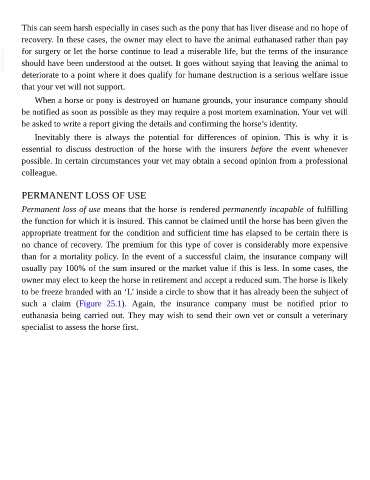Page 1106 - The Veterinary Care of the Horse
P. 1106
This can seem harsh especially in cases such as the pony that has liver disease and no hope of
recovery. In these cases, the owner may elect to have the animal euthanased rather than pay
VetBooks.ir for surgery or let the horse continue to lead a miserable life, but the terms of the insurance
should have been understood at the outset. It goes without saying that leaving the animal to
deteriorate to a point where it does qualify for humane destruction is a serious welfare issue
that your vet will not support.
When a horse or pony is destroyed on humane grounds, your insurance company should
be notified as soon as possible as they may require a post mortem examination. Your vet will
be asked to write a report giving the details and confirming the horse’s identity.
Inevitably there is always the potential for differences of opinion. This is why it is
essential to discuss destruction of the horse with the insurers before the event whenever
possible. In certain circumstances your vet may obtain a second opinion from a professional
colleague.
PERMANENT LOSS OF USE
Permanent loss of use means that the horse is rendered permanently incapable of fulfilling
the function for which it is insured. This cannot be claimed until the horse has been given the
appropriate treatment for the condition and sufficient time has elapsed to be certain there is
no chance of recovery. The premium for this type of cover is considerably more expensive
than for a mortality policy. In the event of a successful claim, the insurance company will
usually pay 100% of the sum insured or the market value if this is less. In some cases, the
owner may elect to keep the horse in retirement and accept a reduced sum. The horse is likely
to be freeze branded with an ‘L’ inside a circle to show that it has already been the subject of
such a claim (Figure 25.1). Again, the insurance company must be notified prior to
euthanasia being carried out. They may wish to send their own vet or consult a veterinary
specialist to assess the horse first.

